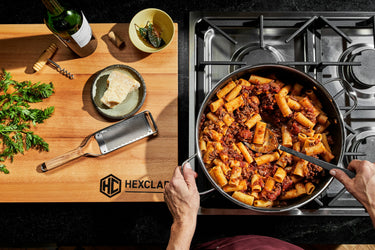What is Ragù? A History of The Popular Sauce, Plus 5 Tips

Ragù (pronounced rah-goo), aka ragù Bolognese, is a meat-based sauce typically served with pasta. It hails from the Northern Italian region of Bologna. The word ragù comes from the 17th-century French word ragoûter, which meant to “awaken the appetite” and also had the connotation of a highly seasoned meat and vegetable stew. Both meanings are apt when it comes to this slow-cooked meat sauce. Though cooks will argue about exactly how a traditional ragù alla Bolognese should be made, one thing is clear: A ragù should be made almost entirely of meat and simmered for a long time to allow the flavors to meld together and create a rich and complex sauce. Worrying about whether a version of ragù is authentic or not is missing the point. As you’ll see, the sauce evolved from a French dish into the many renditions it’s beloved for today.
The History of Ragù
The history of ragù is long and varied and debated—as many classic Italian dishes are—as to how long it’s been a staple of the cuisine. According to The Economist, the sauce was first recorded in Italy after Napoleon’s invasion in 1796. Shortly after, the dish popped up in the kitchen of the Cardinal of Imola (a small town in Bologna), where his chef, Alberto Alvisi, adapted the French ragoût into an pepper- and cinnamon-spiked meat sauce served with maccheroni (a word that referred to all pasta at that time). Though meat stews were already popular in the region at the time, until then, they were not served with pasta.
It wasn’t until 1891 that a ragù Bolognese was documented that resembles the sauce today. A businessman named Pellegrino Artusi documented the sauce in his cookbook La scienza in cucina e l’arte di mangiar bene. He described a veal-based sauce that included pancetta, butter, onion, carrot, celery, flour, broth, salt, pepper, and nutmeg. The sauce would then be tossed with a thick pasta and Parmesan cheese. Optional ingredients for the sauce included dried mushrooms, sliced truffle, chopped, cooked chicken liver, or cream.
Today’s tomato-heavy spaghetti Bolognese is a far cry from the traditional ragù that Alvisi made or the now-popular Italian versions that are slow-brasises of veal, pork, and/or beef. Spaghetti bolognese’s popularity is attributed to soldiers bringing Italian meat and pasta dishes back to the US and UK after the second world war, as well as Italian immigrants in America adapting their own dishes to the ingredients of their new lands. So, while spaghetti has become the popular companion of Bolognese world wide, you’re more likely to see Bolognese sauce served with pappardelle or fettuccine in Northern Italy.
Ragù is a versatile sauce that is at home beyond pasta. Serve your ragù alla Bolognese in lasagna, spooned over creamy polenta, tossed with gnocchi, or as a filling for stuffed vegetables.
5 tips for making a great ragù alla Bolognese
- Use high quality meat. Since the sauce features a high proportion of meat to the other ingredients, the flavor and texture will shine through.
- Give the sauce the time it needs. Slow-cooking the meat is crucial for tenderness, and a long simmer will allow the flavors to meld.
- Don’t feel you need to add tomatoes. You can tell surprised guests that your ragù alla Bolognese is the traditional kind. Or, use a bit of tomato paste for color, or opt for whatever canned tomatoes you like. Recipes evolve with the times—some will swear by canned tomato puree above all else, but what’s important is that you enjoy the sauce.
- Make sure the meat browns well. Whether you’re using ground meat or cubed meat that falls apart while braising, getting a decent sear on the meat will infuse the sauce with rich flavor.
- Make it your own. Add fish sauce to amp up the umami or make a sauce that’s half lentils and half ground meat. Mix different types of meat (beef, pork, lamb, veal, chicken) for a unique flavor profile, or draw on the 18th century ragù by adding a dash of cinnamon. Give it a kick with hot peppers (a popular take in Calabria) or add sausage (a favorite in Sicily).





